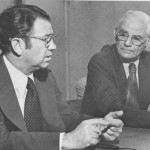Indiana can lay claim to its own contribution to the scientific hoaxes that captivated so many Americans in the nineteenth and early twentieth century. Between 1850 and 1935, a number of so-called ‘petrified’ human bodies were discovered in America—including one in Evansville, Indiana, in 1902.
“A petrified human body has never been scientifically documented,” write authors Carl Runyon and Randy K. Mills, “. . . [and all] of these discoveries were hoaxes—perpetuated by profit seekers, perpetuated by pseudosciences, but believed by a curious public”.
In 1902, an ambitious program to improve river transportation was underway along the Ohio River. Workers were dredging the river and building locks, dams, and dikes along its length. John G. Eigenman of Rockport, Indiana, got a job supervising the dredging of gravel bars along the Evansville waterfront. As his workers were unloading a barge of sand onto the river bank, Eigenman (according to later newspaper accounts) noticed something that resembled a human body in the water. Eigenman ordered his men to recover the object, which appeared to be the body of a small man that had seemingly turned to stone.
Eigenman stored it in a nearby building while he considered his options, but word soon got out about the discovery. A local newspaper reporter and a few unnamed doctors and “men of science” were allowed to briefly view the “body,” and several were willing to generally confirm Eigenman’s claims to the press. “Petrified man fever” set in as reports went out through the state. Governor Winfield Durban traveled down from Indianapolis to view the object, proclaimed it a genuine petrified human being, and pronounced: “It is the most wonderful thing I have ever seen.”
The public clamored for information about the stone man’s identity. Various theories emerged concerning how he had died, from drowning to murder. Newspapers dug up old boating accidents, wives identified the stone man as their long-lost husbands, and one person even anonymously confessed to having killed the stone man during the Civil War.
Not everyone believed the object was human, though. Evansville’s police chief was among those who were extremely suspicious of the whole affair. Even as Eigenman was charging admission for public viewings of the stone man, one of his own workers, Louis Lamb, who had helped pull the body out of the river, sued Eigenman over ownership of the object. While the trial was underway, the stone man disappeared.
Without a body, Eigenman won the lawsuit, but the mystery over the stone man’s whereabouts deepened. For his part, Eigenman left Evansville in a hurry, and one month later, he was found in his Spencer County hometown of Rockport, where he was once again charging visitors to see the stone man. Eigenman claimed in the local paper that the stone man had “come to life and walked the distance”. The stone man was never in the news again after that.
A Moment of Indiana History is a production of WFIU Public Radio in partnership with the Indiana Public Broadcasting Stations. Research support comes from Indiana Magazine of History published by the Indiana University Department of History.
Source: Carl Runyon and Randy K. Mills, “‘The Most Wonderful Thing I Have Ever Seen’: Indiana’s Contribution to Petrified Man Hoaxes,” Indiana Magazine of History 104, no. 4 (Dec. 2008): 367-378.






















